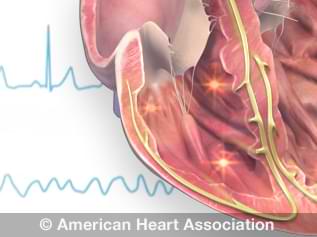How Do You Know Tachycardia Is About to Hit

ECG strip showing a normal heartbeat

ECG strip showing tachycardia
Tachycardia refers to a eye rate that'southward too fast. How that'due south defined may depend on your age and physical status.
Mostly speaking, for adults, a heart rate of more 100 beats per minute (BPM) is considered too fast.

View an animation of tachycardia.
Types of tachycardias
Atrial or Supraventricular Tachycardia (SVT)
Atrial or supraventricular tachycardia (SVT) is a fast heart rate that starts in the upper chambers of the eye. Some forms of this detail tachycardia are paroxysmal atrial tachycardia (PAT) or paroxysmal supraventricular tachycardia (PSVT).
With atrial or supraventricular tachycardia, electric signals in the center's upper chambers fire abnormally. This interferes with electric impulses coming from the sinoatrial (SA) node, the centre'south natural pacemaker.
The disruption results in a faster than normal heart charge per unit. This rapid heartbeat keeps the heart's chambers from filling completely betwixt contractions, which compromises blood period to the rest of the trunk.
A profile for atrial or SVT
In general, those almost likely to accept atrial or supraventricular tachycardia are:
- Children (SVT is the virtually common type of arrhythmia in kids)
- Women, to a greater degree than men
- Anxious young people
- People who are physically fatigued
- People who beverage large amounts of coffee (or caffeinated substances)
- People who drink alcohol heavily
- People who smoke heavily
Atrial or SVT is less commonly associated with heart set on or serious mitral valve disease.
Symptoms and complications
Some people with atrial or supraventricular tachycardia may have no discernible symptoms. Others may experience:
- Fainting (syncope)
- Lightheadedness or dizziness
- Rapid heartbeat or palpitations
- Fluttering in the breast
- Bounding pulse
- Chest pressure, tightness or pain (angina)
- Shortness of breath
- Fatigue
In farthermost cases, those suffering with atrial or SVT may likewise experience:
- Unconsciousness
- Cardiac arrest
Handling for Atrial or SVT
If you accept atrial or SVT, information technology's possible that you won't need handling.
But if the episodes are prolonged, or recur often, your doctor may recommend treatment, including:
- Carotid sinus massage: A healthcare professional person can apply gentle pressure on the neck, where the carotid avenue splits into two branches.
- Pressing gently on the eyeballs with eyes closed. Caution: This procedure should be supervised carefully by a healthcare physician.
- Valsalva maneuver: This consists of property your nostrils closed while bravado air through your nose.
- Using the dive reflex: The swoop reflex is the torso'southward response to sudden immersion in water, especially cold water.
- Sedation
- Cutting downwards on coffee or caffeinated substances
- Cut down on alcohol
- Quitting tobacco use
- Getting more rest
In patients with Wolff-Parkinson-White Syndrome, medications or ablation may exist needed to control paroxysmal supraventricular tachycardia (PSVT).
Sinus Tachycardia
Sinus tachycardia is a normal increment in the center rate. In this status, the heart'south natural pacemaker, the sinoatrial (SA) node, sends out electrical signals faster than usual.
The middle rate is faster than normal, simply the centre beats properly.
Causes of sinus tachycardia
A rapid heartbeat may be your body's response to common conditions such every bit:
- Feet
- Fright
- Astringent emotional distress
- Strenuous do
- Fever
- Some medicinal and street drugs
Other, less common causes may include:
- Anemia
- Increased thyroid activeness
- Middle musculus impairment from eye attack or centre failure
- Astringent bleeding
Approach to handling
Your doctor should consider and treat the cause of your sinus tachycardia, rather than merely treating the condition. Simply slowing the heart rate could cause more harm if your rapid heartbeat is a symptom of a more than serious or long-term problem.
Ventricular Tachycardia
Ventricular tachycardia is a fast heart rate that starts in the center'due south lower chambers (ventricles). This blazon of arrhythmia may be either well-tolerated or life-threatening, requiring firsthand diagnosis and treatment.
The seriousness depends largely on whether other cardiac dysfunction is present and on the degree of the ventricular tachycardia.
Explaining the trouble
In cases of ventricular tachycardia, electrical signals in the eye'south lower chambers burn down abnormally. This interferes with electrical impulses coming from the sinoatrial (SA) node, the heart'south natural pacemaker.
The disruption results in a faster than normal heart rate. This rapid heartbeat keeps the heart's chambers from filling completely betwixt contractions, which compromises blood flow to the residue of the body.
Causes of ventricular tachycardia
Ventricular tachycardia is almost ofttimes associated with disorders that interfere with the center'southward electrical conduction system. These disorders can include:
- Lack of coronary artery claret menstruation, depriving oxygen to middle tissue
- Cardiomyopathy distorting the heart's structure
- Medication side effects
- Illicit drugs such as cocaine
- Sarcoidosis (an inflammatory disease affecting skin or body tissues)
Range of symptoms
Symptoms for ventricular tachycardia vary. Common symptoms include:
- Dizziness
- Palpitations
- Shortness of jiff
- Nausea
- Lightheadedness
- Falling unconscious
- Cardiac arrest, in extreme cases
Handling options
The cause of your ventricular tachycardia will inform your treatment options. Possible approaches include:
- Medication
- Radiofrequency ablation
- Surgery
- Firsthand electrical defibrillation, in farthermost cases
Printable Arrhythmia Information Sheets
Source: https://www.heart.org/en/health-topics/arrhythmia/about-arrhythmia/tachycardia--fast-heart-rate
Post a Comment for "How Do You Know Tachycardia Is About to Hit"